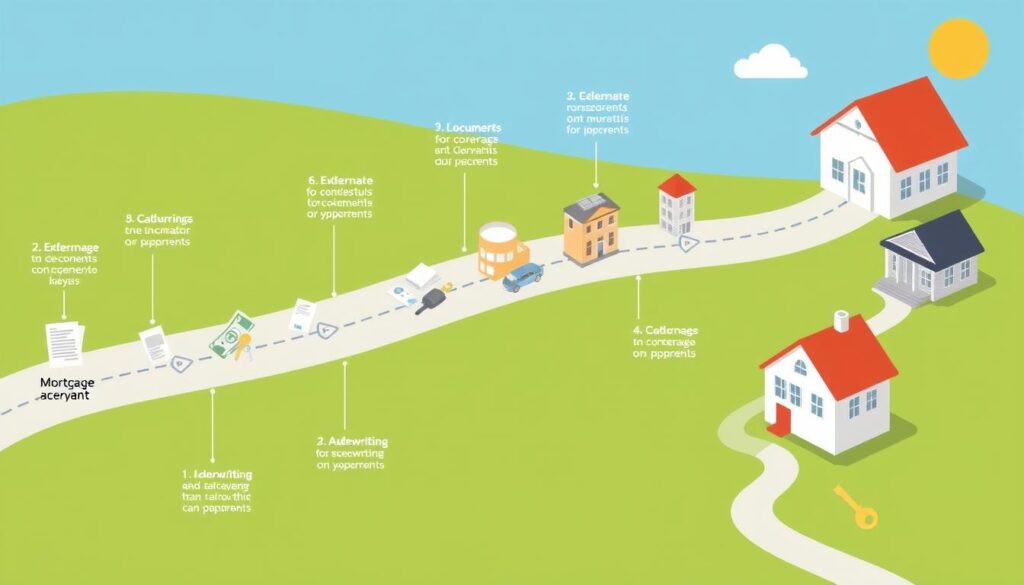Navigating the maze of mortgage approval steps can seem daunting, particularly for those setting foot on this journey for the first time. As seasoned guides through the complexities of getting mortgage approved, we’re here to provide you with an empowering blueprint to make your voyage from aspiring homeowner to keyholder as seamless as possible. A crucial part of this journey is the home loan approval checklist—a strategic compilation of essential milestones, acting as your compass from the initial budget analysis to the thrill of closing day.
Our unique blend of expertise and advocacy ensures that each stage of the process, whether it’s obtaining a mortgage preapproval or selecting the right lender, is approached with attentive care and diligence. This preparation not only smoothes out potential bumps in the road but also positions you a step ahead in the dynamic real estate market.
Key Takeaways
- Determine your budget early to establish affordability.
- Obtain a mortgage preapproval to make your offer more competitive.
- Thoroughly review your credit report before applying for a loan.
- Review the mortgage approval steps and gather necessary documents in advance.
- Consider the impact of your Debt to Income Ratio on loan terms.
- Always prepare for additional requirements such as home inspection and homeowner’s insurance.
Understanding the Elements of a Mortgage Payment
When preparing ourselves for a mortgage, it’s crucial that we grasp the different elements that comprise a mortgage payment which inevitably impacts the mortgage approval timeline and the amount of the monthly outlay. The principal components, including the loan principal, interest payments, and escrow accounts that cover property taxes and homeowner’s insurance, all factor into the overall affordability of a house.
Given the fluctuating nature of current mortgage interest rates, understanding how these rates affect your payment is essential. A difference of even 1% can significantly alter monthly payments as well as the overall cost of the loan. For example, for a $100,000 mortgage at 6% interest, your combined monthly principal and interest payment on a 30-year mortgage would be $599.55.
It’s wise to remember that the higher your credit score, the better chance you have of securing favorable mortgage rates, which can substantially lower your payments. A robust credit score tends to open the door to lower interest rates, thereby enhancing your purchasing power and softening the impact of higher rates on your budget.
| Component | Monthly Impact | Annual Necessity |
|---|---|---|
| Principal | Varies by down payment | Reduces loan balance |
| Interest Rate | Depends on rate | Cost of borrowing |
| Property Taxes | 1/12 of annual tax | Paid via escrow |
| Homeowner’s Insurance | 1/12 of annual premium | Mandatory for loan |
| HOA Fees | Varies by property | Covers communal expenses |
| Private Mortgage Insurance (PMI) | 1/12 of annual premium | Required if down |
Furthermore, staying informed about the current mortgage interest rates can significantly influence decisions related to refinancing or purchasing a new home. With the help of mortgage calculators, one can visualize how different rates, down payments, and other factors will affect monthly payments.
Overall, our understanding of all these components not only prepares us more robustly for the mortgage approval timeline but also ensures we make financially sound decisions in one of life’s biggest investments. By monitoring current mortgage interest rates and paying attention to each component of a mortgage payment, we maximize our ability to manage the commitment effectively.
Navigating the Mortgage Preapproval Journey
Embarking on the path to homeownership starts confidently with securing a mortgage preapproval. This crucial step not only clarifies your financial stance but also positions you as a serious contender in the competitive real estate market. Understanding the nuances of the mortgage approval steps and the loan approval process can significantly enhance your buying potential.
Why Preapproval Strengthens Your Offer
Preapproval serves as a powerful tool for buyers, indicating to sellers and their agents that you have the backing of a financial institution. This affirmation is based on a meticulous review of your financial history, including income, debts, credit score, and assets, distinguishing it from mere prequalification estimates.
The Difference Between Preapproval and Prequalification
While often used interchangeably, preapproval and prequalification are distinct in their depth of scrutiny and reliability. Prequalification gives a broad estimate of what you might afford, based on unverified financial information you provide. In contrast, preapproval delves deeper, requiring documentation and checks, thus carrying more weight with sellers.
Preparing Your Financial Documents for Preapproval
Gather necessary financial documents early to streamline the preapproval process. Essential paperwork includes recent pay stubs, W2s, tax returns, bank statements, and your credit report. This preparedness not only expedites the loan approval process but also helps identify any issues that might need resolving to enhance your creditworthiness.
Understanding these initial stages in the mortgage approval steps prepares you to present a robust financial profile, setting the stage for a successful home purchase. A preapproval letter can significantly influence negotiations in your favor, demonstrating your readiness and financial capability to close the deal.
Finding the Right Home and Making an Offer
Stepping into the house hunting phase is an exhilarating part of the mortgage process. Equipped with your preapproval, you can confidently navigate the market. When you find a home that meets your checklist, it’s crucial to move swiftly. Our home loan approval checklist ensures you’re ready both financially and emotionally to commit. Once you make an offer on a house, you demonstrate your seriousness through an earnest money deposit, which can often set you apart in competitive markets.
Understanding the dynamics of negotiation, such as bargaining over the price or terms like necessary repairs, plays a critical role. Here, your real estate agent’s expertise becomes invaluable, helping tailor your offer to be both competitive and realistic. Use the insights gained from your home loan approval checklist to align your offer with what you’ve preapproved for, keeping in mind the additional costs that come with home ownership.
| Loan Type | Minimum Credit Score | Down Payment | Interest Rate |
|---|---|---|---|
| Conventional Mortgage | 620 | Varies (0%-20%) | 6.39% |
| FHA Loan | 580 | 3.5% | 5.81% |
| Jumbo Loan | 670 or higher | 10-20% | 6.62% |
Moreover, consider inflation rates and their impact on housing prices. In 2024, while inflation tempered, housing prices remained robust. This suggests a buyer’s market might not emerge soon, emphasizing the importance of making a solid, well-planned offer.
Lastly, prepare for various outcomes. Whether it’s a bidding war or a smooth path to purchase, knowing the nuances of the local market, aided by real-time data and your agent’s insights, can help you effectively navigate this stage.

Ready to make your move? Use this knowledge to your advantage and make a home offer that is not just a bid, but a strategic step towards securing your ideal home.
Selecting the Best Mortgage Lender for You
Choosing the right mortgage lender is a critical step in getting mortgage approved efficiently. It involves understanding various lending options and securing the most favorable terms that align with your fiscal health and home buying aspirations. We’ll dive into how you can effectively shop for the best mortgage rates, assess distinct loan opportunities, and finalize your lender choice after making a home offer.
Shopping for the Best Mortgage Rates
To ensure financial prudence when seeking mortgage approval steps, it’s essential to compare rates from at least three different lenders. Studies show that borrowers who conduct thorough comparisons tend to save significantly over those who don’t. With more than 5,100 federally insured credit unions and numerous nonbank mortgage lenders predominantly offering online services, options are plentiful but vary greatly in terms of rates and conditions.
Understanding Loan Options and Their Impact on Rates
Different types of loans — such as conventional, VA, FHA, and USDA — influence not only the interest rates but also the overall costs including insurance premiums and down payments. For instance, conventional loans may allow for down payments as low as 3%, but anything below 20% typically requires private mortgage insurance (PMI). Loan terms also play a crucial role; whether you opt for a 15-year or a 30-year term can affect both your monthly payments and the total interest accrued over the life of the loan.
Finalizing Lender Choice After Home Offer Acceptance
Once your offer on a home is accepted, the next step in the mortgage approval steps is to finalize your lending choice. At this stage, revisit the initial lenders you considered to confirm their loan terms, rates, and fees as outlined in their loan estimates — documents that lenders must provide within three days of your application. Evaluating these factors systematically ensures you are selecting a lender that best fits your long-term financial strategy and objectives.
Throughout this process of getting mortgage approved, maintaining a clear understanding of your financial limits according to the 28/36 rule — which suggests that your housing costs should not exceed 28% of your monthly gross income — will guide you in making a sustainable commitment without overstretching your financial boundaries.
By leveraging detailed comparisons and informed decisions, you are poised to secure a mortgage that not only meets your immediate needs but also protects your financial future.
Mortgage approval process
When embarking on the journey of purchasing a home, understanding the mortgage approval timeline is crucial. This timeline can vary significantly, but on average, the closing time for a new-purchase mortgage ranges from 40 to 50 days. Each step, from loan application to final approval, plays a pivotal role in the loan approval process. Let’s walk through some key phases to clarify what buyers can expect.
Initially, the pre-approval process, which is often misunderstood as an immediate step, actually takes anywhere from 1 to 3 days. This stage sets the foundation by assessing buyers’ creditworthiness and financial readiness, impacting subsequent stages, including the crucial underwriting process.
Following pre-approval, buyers typically enter the property search phase, which can be lengthy, stretching over several months in competitive markets. Once a property is selected, completing the mortgage application usually takes 1 to 2 days, provided all necessary documents are readily available.
The underwriting phase is the most time-intensive, requiring anywhere from a few days to several weeks. During this period, underwriters meticulously verify financial details, such as income and credit history, ensuring that borrowers meet specific lending criteria like those set by Fannie Mae— a conventional loan requires a maximum 97% LTV ratio, a minimum credit score of 620, and a maximum 36% DTI ratio.
Underwriting also involves a detailed assessment of the property’s value through an appraisal, the results of which can significantly influence the final loan decision—be it approval, conditional approval, suspension, or denial. This is followed by the final steps toward closing, which includes title searches and purchasing title insurance. Typically, the closing process concludes about 30-45 days after signing the purchase agreement, culminating in the final transaction that lasts about an hour.
Throughout each stage of the loan approval process, it’s beneficial for buyers to organize financial documents early and aim to improve their credit score by managing debt effectively and considering larger down payments when feasible. These preparative steps can significantly enhance the likelihood of a favorable mortgage approval outcome.
The In-depth Mortgage Application Process
Embarking on your journey to homeownership begins with understanding the critical mortgage approval steps that lay the foundation for securing your future residence. This comprehensive guide will illuminate the path from start to finish, focusing on current mortgage interest rates, essential documentation, and the influence of your financial history.
Documents You’ll Need to Apply for a Mortgage
During the mortgage application process, lenders require a detailed record of your financial life. This includes but is not limited to: W-2 forms, recent pay stubs, bank statements, and, for those self-employed, profit and loss statements. Proper documentation is crucial as it influences not only the approval decision but also the computation of feasible loan amounts and terms.
The Impact of Credit History on Mortgage Approval
Your credit history is imperative in determining both your eligibility and the rates you are offered. A robust credit score can afford you lower current mortgage interest rates, significantly reducing the life-long cost of the loan. Conversely, a less than perfect credit score might still secure approval but could lead to higher rates and added costs.
Handling the Loan Estimate: Rates, Fees, and Terms
Upon completing your application, you will receive a loan estimate. This document outlines your prospective loan’s interest rates, fees, and repayment terms. The importance of this estimate lies in its limited validity—typically only 10 days—prompting a timely decision to lock in favorable current mortgage interest rates. It is advisable to meticulously review this estimate to understand fully all associated costs and terms before proceeding.

Understanding these key mortgage approval steps and keeping an eye on current mortgage interest rates can significantly influence your approvals and the overall cost of your mortgage. Be prepared, be informed, and step confidently towards purchasing your new home.
Home Inspection Insights
Understanding the vital role of the home inspection process in real estate transactions in California sheds light on why both buyers and sellers should prioritize this step. For potential homeowners, it’s essential to integrate the home inspection process into your home loan approval checklist to ensure you fully comprehend the state of the property you intend to purchase.
Certified home inspectors in California rigorously evaluate key aspects of the property, including the structural components, roofing, HVAC systems, plumbing, and electrical systems. This thorough assessment helps uncover any potential issues that might not be visible during a standard walk-through.
- Structural integrity and foundation condition
- Quality and lifespan of the roof
- Efficiency and current state of HVAC systems
- Electrical systems and safety
- Plumbing fixtures and potential leaks
The findings from a home inspection can serve as a powerful tool in negotiation processes, potentially saving buyers significant amounts of money in post-purchase repairs. Moreover, having this information allows you to make informed decisions about proceeding with the purchase or renegotiating terms.
For sellers, opting for a pre-listing home inspection provides an opportunity to identify and address issues beforehand, enhancing the property’s marketability and streamlining the selling process. This proactive approach can lead to more favorable terms and a smoother transaction for all parties involved.
In California, where market conditions are highly competitive and the median home price is nearing $900,000, the investment in a home inspection is minimal compared to the risks of unforeseen repairs and issues that could arise post-purchase. Therefore, whether securing a mortgage through a conventional loan or a VA loan, including a home inspection in your purchasing plan is advised, although it is not mandatory for VA loan approval.
By putting emphasis on the importance of the home inspection process, you ensure a safer investment and contribute to a transparent and fair trading environment in the real estate market.
The Role of Home Appraisal in Mortgage Approval
Understanding the importance of home appraisal within the mortgage approval timeline is crucial for both buyers and lenders. An appraisal acts as a safeguard, ensuring that the property value assessment reflects the real market value, which in turn influences the entire loan process.
How Property Value Impacts Your Mortgage
A key component affecting the mortgage structure is the Loan-to-Value Ratio (LTV), which requires a thorough property value assessment. This ratio directly impacts the terms of your mortgage; a lower LTV often means more favorable loan conditions due to reduced lender risk.
Navigating Appraisal Outcomes and Their Implications
When the appraisal value does not meet expectations, it can result in significant delays or modifications in the mortgage approval process. Addressing these discrepancies quickly and efficiently is essential to moving forward with your home purchase.
| Component | Description | Impact on Mortgage |
|---|---|---|
| LTV Ratio | Calculated by dividing the loan amount by the home’s appraised value | Dictates risk level and loan terms |
| Property Issues | Structural problems or safety concerns identified during appraisal | Potential cause for mortgage denial |
| Appraisal Cost | Varies from $600 to $2,000 based on property type and size | Borne by buyer or negotiated to be paid by the seller |
| Discrepancies in Value | Differences between appraised value and expected price | May necessitate additional negotiation or funding adjustments |
| Types of Appraisal | Includes hybrid, desktop, and drive-by appraisals | Adaptability to different verification needs and regulatory demands |
Understanding Underwriting in the Loan Approval Process
As you move forward on your journey toward getting mortgage approved, the underwriting process emerges as a critical step. This phase, where lenders scrutinize every detail of your financial background, is all about ensuring you meet their stringent lending criteria. From evaluating your creditworthiness to assessing risk factors associated with your loan application, underwriting sets the stage for the final loan decision.
Underwriters base their evaluation on the three C’s of underwriting: credit, capacity, and collateral. This includes looking deeply into your credit reports to check your payment history across various loan types, calculating your debt-to-income ratio to figure out your repayment capability, and conducting a property valuation to ensure the home you’re buying can adequately secure the loan.
| Metric | Details |
|---|---|
| Credit Score Required | Minimum 620 for conventional loans, 580 for FHA loans |
| Debt-to-Income Ratio | Typically must be below 43% for home loan approval |
| Property Valuation Factors | Size, location, condition, and market comparables |
| Underwriting Duration | Can range from a few days to 45 days, depending on individual case complexity |
During this underwriting phase, your responsiveness to the lender’s requests for further documentation plays a pivotal role. Swiftly addressing these requests not only facilitates the underwriting process but also accelerates your journey toward getting mortgage approved. Furthermore, it’s essential to ensure that all your financial statements are accurate and reflect financial stability, paving the way for a successful mortgage approval.
Maintaining honest and transparent communication about your finances—including any anomalies in your credit reports—is crucial. Such integrity helps underwriters assess your application fairly and thoroughly, potentially leading to a favorable outcome. Remember, the underwriting process, while meticulous, is fundamentally a protection for both the borrower and the lender against future financial risks.
Therefore, as you navigate through the complexities of the underwriting stage, remember that every detail examined is a step closer to securing your home through a well-evaluated and safe lending agreement.
Counting Down to Closing Day
As we approach the final stages of the mortgage approval steps, it’s crucial to focus on the closing process, a definitive phase marking the transition from applicant to homeowner. The culmination of these efforts hinges on meticulous preparation and understanding of what the closing entails.
Preparing for Closing Costs and Down Payment
Understanding the financial layout for the closing costs and down payment is key. Typically, closing costs range from 2% to 5% of the purchase price. These costs cover various fees, including title searches, attorney’s expenses, and appraisal and lender fees. We also ensure that our clients are ready with their down payment, a significant portion of the purchase price, which demonstrates their commitment to the investment.
The Final Steps Before You Get the Keys
The last steps of the closing process involve reviewing and signing the Closing Disclosure, which details the loan terms, monthly payments, and all associated costs. Clients are given a mandatory three-day period to review this document, ensuring clarity and accuracy before signing. Once all documents are verified and signed, the practical transfer of ownership takes place, and the keys to the new home are handed over.
| Step | Duration | Details |
|---|---|---|
| Loan Packaging & Lender’s Disclosures | 1-2 days | Initial documentation and disclosure of loan terms. |
| Processing / Credit Approval | 2-3 days | Assessment of creditworthiness and initial approval. |
| Initial Underwriting Approval | 2-3 days | Fine-tuning loan details, assessing risks. |
| Final Underwriting Approval | 1-2 days | Final approvals before issuing the Closing Disclosure. |
| Closing & Recording | 2 days post-cooling off | Signing of final documents and recording of the loan. |
In summary, the steps toward closing a mortgage involve not only financial readiness but also an in-depth understanding of the procedural timeline. We guide our clients through each step, ensuring they feel confident and prepared as they make one of their most significant financial decisions.
Conclusion
As we reach the end of our guide, it’s clear that navigating the mortgage process is intricate and multifaceted—from understanding budget constraints and obtaining preapproval to selecting a lender and going through with the full mortgage application. The typical journey to securing your home loan spans across an average of 30 to 45 days, although variations such as loan types or unforeseen complexities can extend this timeframe. With robust documentation and preparation on your part, coupled with a responsive attitude during the application phase, you can grease the wheels for a smoother transaction.
Crafting a streamlined pathway to securing your home loan hinges closely on knowledge—the insight that a credit score ranging from 720 to 850 opens up excellent possibilities, or that closing costs might claim 2% to 6% of your loan amount. These facts don’t just prepare you for the expectations of lenders; they empower you to present your best financial portrait. Further, adherence to guidelines—such as halting any new debt acquisitions during the underwriting stage or meticulously reviewing your Closing Disclosure—can dramatically influence the final outcome, leaving fewer chances for surprises when you’re on the brink of homeownership.
In the pursuit of mortgage approval, each step carries significant weight, from the initial prequalification which gives you a borrowing estimate, to the climactic point where you sign your closing documents and the keys to your new abode are finally placed in your hands. The closing costs, the final terms contained within the Loan Estimate and Closing Disclosure, and the rigorous assessment by underwriters are all pivotal to the completion of your milestone. Suffice it to say, these stages aren’t just procedural—they’re the foundational blocks of achieving the homeowner dream. Armed with this knowledge, you are exceedingly better placed to manage this process within the United States efficiently and effectively.







